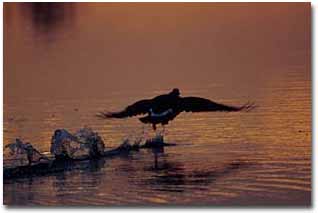
Pocomoke Sound WMA, with over 900 acres of marsh and tidal mud flats, is located in southern Somerset County. The property provides excellent habitat for ducks, wading birds and shorebirds and more recently has become home to growing populations of osprey and barn owls.
What To See
From April through September bird enthusiasts come from miles around to see the glossy ibis probing its long bill in the mud for worms and other small marine life. Herons and egrets hunt the extensive marsh for small fish while ducks paddle through the shallows in search of their favorite plants. Osprey nest on nearby channel markers and from April to September barn owls use nest boxes on the marsh. Check out a map of the area.
What To Do
Pocomoke Sound is famous for waterfowl and rail hunting. Pursuing rails in the marshes and shallow channels is an historic Chesapeake Bay sport . Along the shoreline and in adjacent waters, crabbing and fishing for sea trout, flounder, croaker, rockfish, spot and white perch are popular. Nature photographers visit year-round.
Area Regulations
- Use of Pocomoke Sound WMA is generally permitted seven days a week throughout the year.
- Hunting is allowed in accordance with open seasons and shooting hours, unless otherwise noted.
- All State and Federal Hunting Laws and Regulations are applicable.
- Trapping is by permit only.
- No motorized vehicles are allowed.
Non-hunting Users Guide
- Non-hunting visitors are welcome.
- Be aware of open hunting seasons and visit accordingly.
- Season dates available in newspapers, on the Internet, and at some area stores.
- Because of the soggy soil, hiking is a challenge, even with chest waders or hip boots.
- Visitors to the management area should be aware that there may be biting flies, mosquitoes, and ticks present during April - November.
Site Management Goals
- Tidal marsh habitat conditions on the WMA limit management practices that can be implemented.
 Directions
Directions
From U.S. Route 13, take MD 413 south to Crisfield. Access is by boat only, via Crisfield and Jenkins Creek public boat ramps. For additional information, contact the Wellington Wildlife Office at (410) 651-2065.
Click Here for Map
This area is a part of Maryland’s Department of Natural Resources public land system and is managed by the Wildlife and Heritage Service. The primary mission of the WMA system is to conserve and enhance wildlife populations and their respective habitats as well as to provide public recreational use of the State’s wildlife resources.
Eighty-five percent of the funding for Maryland's state wildlife programs comes from hunting license fees and a federal excise tax on sport hunting devices and ammunition. The federal aid funds are derived from the Federal Aid in Wildlife Restoration (or Pittman-Robertson) Fund, which sportsmen and women have been contributing to since 1937. Each state receives a share of the funds, which is administered by the U. S. Fish and Wildlife Service; these funds are used for wildlife conservation and hunter education programs, including the management of the WMA system.
Other sources of funds for land acquisition include Program Open Space Funding for Maryland's State and local parks and conservation areas, provided through The Department of Natural Resources' Program Open Space. Established in 1969, Program Open Space symbolizes Maryland's long-term commitment to conserving natural resources while providing exceptional outdoor recreation opportunities.